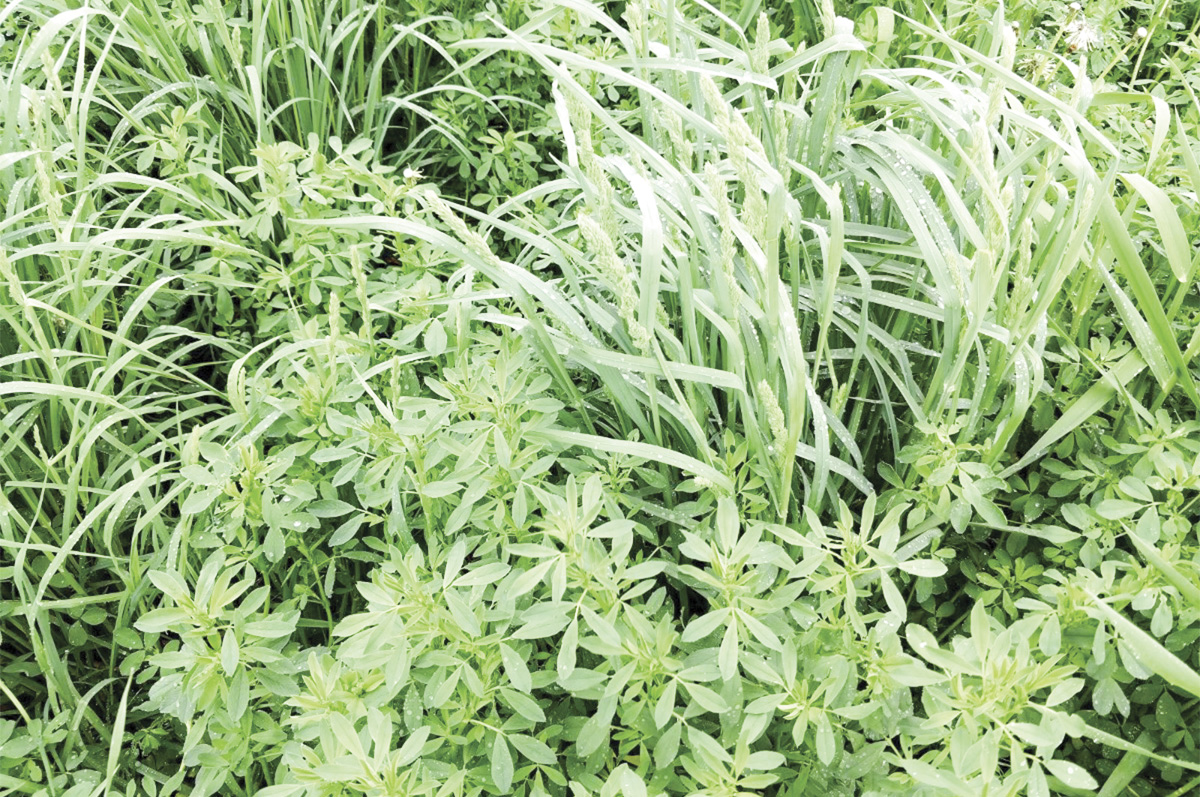Alfalfa is well established in America’s livestock industry as a high-yielding and high-quality forage, and undoubtedly it will continue in its current role as an important forage crop. However, significant genetic advancements, new technologies and innovative management techniques are set to change the landscape of how alfalfa will be used in the future.
Plant breeders are currently developing alfalfa varieties that can buffer alfalfa yields against the adverse effects of extreme weather using what can be labeled as “climate change genetics.”
Future growth of alfalfa as a crop, however, may lie in increasing its use in less traditional areas such as grazing, alfalfa-grass mixes and novel applications.
These genetics combined with other novel traits will solidify and expand alfalfa’s use on the farm, as well as enhance its value as a forage for both yield and quality.
Alfalfa production in stress environments
Alfalfa is one of the few crops that, despite extreme fluctuations in weather or growing conditions, can in most cases still produce a crop each year. Plant breeders are enhancing this ability by developing new varieties to increase plant survival and production in the event of extreme weather or other stresses. Several of these genetic improvements are currently available and, when combined with innovative management techniques, are making alfalfa better equipped to face the adverse effects of “climate change.”
The following are a few of these advancements as well as some alternative uses for alfalfa that may enhance its role on the farm in the future:
- Harvest flexibility: Alfalfa genetics with a wider harvest window allow producers to delay harvest seven to 10 days to avoid adverse weather during harvest.
- Improved winter survival of less dormant alfalfa: New genetics are allowing higher-yielding less dormant varieties (fall dormancy = 4 and 5) to be planted farther north in colder environments, thus increasing seasonal yields.
- Drought tolerance and water use efficiency: The reality of climate change is increasing the possibility of long-term droughts in the future. However, genetic improvements in alfalfa are enhancing its ability to produce economic yields with less-than-optimal moisture. Also, improved techniques for managing the timing of irrigation and harvest frequency will allow alfalfa to remain profitable during drought conditions. This, combined with alfalfa’s unique ability to survive extended dry periods by going into a “drought-induced dormancy” with minimal long-term effects, may solidify alfalfa’s use as a crop for water-limited regions.
- Salt tolerance: A significant portion of farmground in the western U.S. is adversely affected by soil or water salinity. Soil salinity also tends to increase during periods of extended drought, since there is limited water available to leach the salts out of the root zone. Varieties with improved genetics that can germinate, survive and produce forage in these marginal saline soils will be another tool to help buffer against the adverse effects of extended drought conditions. New salt-tolerant varieties also have the potential to increase farm revenues by making marginal saline fields more productive.
Improvements in yield and forage quality will increase demand
In recent years, the percentage of alfalfa used in dairy rations has been slowly declining as other feedstuffs have become more available or cheaper. However, alfalfa’s recent significant forage quality improvements may help to reverse that trend.
New genetics with harvest flexibility can improve yield and forage quality. Recent improvements in alfalfa’s fiber digestibility are offering dairies two reasons to reconsider growing or adding alfalfa to the feed rations.
- Reduced lignin content (i.e., fiber digestibility) allows the flexibility to harvest on a normal cutting schedule and obtain higher levels of quality.
- Delayed harvest for seven to 10 days can produce more yield while maintaining acceptable levels of forage quality. More leaves equals higher protein content. Alfalfa varieties are now being developed with a higher leaf-to-stem ratio, increasing the leaf percentage and thus the protein content. Higher protein content makes alfalfa a more viable economical protein source compared to expensive soybean meal that is often used in rations.

Alfalfa-grass mixes are being adopted more widely in western U.S. environments, thanks to the development of grazing-tolerant varieties. Photo provided by Shauni Nichols.
New or expanded roles for alfalfa
Production in stress environments: With recent stress-related genetic improvements, alfalfa is poised to become an important crop choice for more marginal soils and environments.
Alfalfa as a crop rotation to reduce nitrogen fertilizer costs: This is an old concept but very relevant considering current nitrogen fertilizer prices. Alfalfa can supply up to 200 units to succeeding crops. (To enhance this amount, allow the old alfalfa stand to regrow 6 to 10 inches before plowing under.)
Carbon sequestration: Alfalfa is currently being evaluated as a potential candidate for this revenue stream.
Less traditional areas: Alfalfa-grass mixes and grazing
Alfalfa-grass mixes and grazing are more popular in other major alfalfa markets such as Australia and Argentina, where they are major components of their forage systems. Acceptance of alfalfa-grass mixes for haying or grazing has been much more limited in the U.S. These are some new factors U.S. producers should consider in the future:
- Genetic improvements in both alfalfa and grasses are making the two species more compatible in mixes. This combined with new management guidelines may make alfalfa-grass mixes more acceptable to forage producers.
- Grazing increases animal productivity and reduces harvest costs. Grazing is economical and can be successfully managed, as evidenced by the millions of acres of alfalfa grazed worldwide in both alfalfa-grass mixes as well as pure stands.
- Alfalfa grazing-tolerant varieties are bred to survive intensive grazing pressure, while maintaining high forage yields.
New management guides available for alfalfa-grass mixes and grazing
The following two excellent guides can be found on the National Alfalfa and Forage Alliance (NAFA) website.
- Grazing Alfalfa: Economic and Sustainable Use of a High-Value Crop
- Alfalfa Bermudagrass Management Guide








